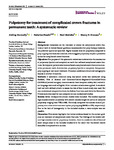Pulpotomy for treatment of complicated crown fractures in permanent teeth: A systematic review

Date
2022-02-16Author
Subject
Metadata
Show full item recordAbstract
<jats:title>Abstract</jats:title><jats:sec><jats:title>Background</jats:title><jats:p>Consensus on the treatment of choice for complicated crown fractures of teeth is limited. Recent guidance recommends vital‐pulp‐therapy; however, the preferred type is not specified. Higher success rates for pulpotomy compared to pulp‐capping have been documented, which suggests pulpotomy may be a preferable option for complicated crown‐fractures.</jats:p></jats:sec><jats:sec><jats:title>Objectives</jats:title><jats:p>The purpose of this systematic review was to determine the success rate of pulpotomy (partial and complete) on teeth that suffered complicated crown fractures. Participants: patients who have suffered a complicated crown fracture to an anterior permanent tooth. Intervention: pulpotomy (partial or complete). Comparator: pulp‐capping or root canal treatment. Outcome: combined clinical and radiographic success at or after 12 months.</jats:p></jats:sec><jats:sec><jats:title>Methods</jats:title><jats:p>A systematic literature using key search terms was conducted using PubMed, Web of Science and Cochrane‐Central‐Register‐of‐Controlled‐Trials (CENTRAL) as well as a grey literature search from inception to May 2021 and without language restricted to English. Strict inclusion criteria were applied. A standardized tool with defined criteria to assess the risk of bias in each study was used. For non‐randomized comparative trials, the Robins‐I tool was used while the Newcastle‐Ottawa scale was used for non‐comparative non‐randomized studies.</jats:p></jats:sec><jats:sec><jats:title>Results</jats:title><jats:p>Seven retrospective clinical studies were included. The studies reported high success rates for pulpotomy with overall success ranges for partial or complete pulpotomy ranging from 75% to 96%. One study compared the success rates of pulpotomy to an alternative treatment option pulp capping (90.9% vs. 67%, respectively). Due to the lack of homogeneity in the included studies, a meta‐analysis was not possible.</jats:p></jats:sec><jats:sec><jats:title>Discussion</jats:title><jats:p>This review highlights the limited evidence based for the current guidance on treatment of complicated crown fractures. The findings of the review indicate high success rates for pulpotomy; however, there is a moderate risk of bias and small sample sizes in the included studies with the result that the overall results should be interpreted with caution.</jats:p></jats:sec><jats:sec><jats:title>Conclusion</jats:title><jats:p>Within the limitations of this review, the benefits and high success rates reported for partial pulpotomy suggest this procedure, rather than pulp‐capping, should be considered as the treatment of choice for both immature and mature teeth that have suffered complicated crown‐fractures.</jats:p></jats:sec>
Collections
Publisher
Place of Publication
Journal
Volume
Issue
Pagination
Recommended, similar items
The following license files are associated with this item:

